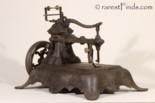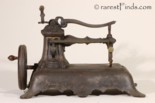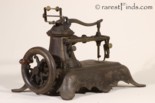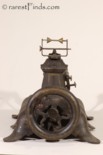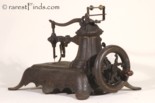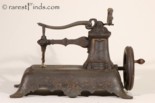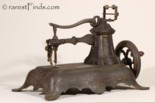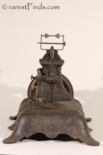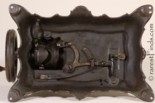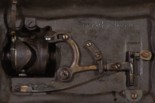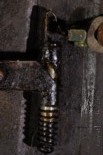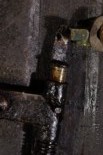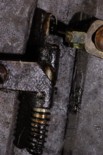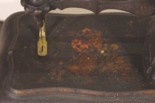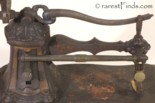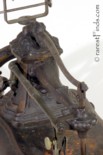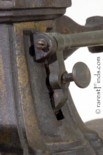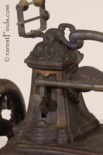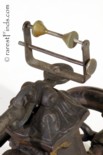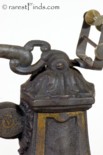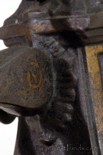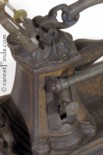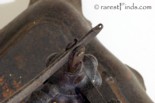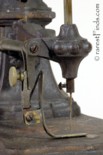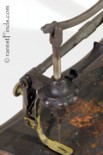Unknown, Early Example Of William C. Watson's Sewing Machine Based On His November 25, 1856 Patent. Price $6,250.
This machine, according to the formost expert in the field, Carter Bays, is unknown and not to be found in any collection; even his book, "THE ENCYCLOPEDIA OF EARLY AMERICAN & ANTIQUE Sewing Machines, IDENTIFICATION & VALUES," considered the bible in collecting early American Sewing Machines, has no picture of this machine! The reason seems to be a simple one; just look at the casting!The casting is very delicate and considering that these machines were transported over long distance on cart-roads back in the 1850's many did not even make it to the destination in one piece! The arm moving the needle has an ornamental feature close to the point of rotation which leaves very little iron in the casting to give it strenght and preventing the arm from breaking, see picture # 22 and others. The leverage of the length of the arm would easily cause the arm to break at its weak point if some force would impact the end of the arm. The arm was silberplated but the siver turned black. The same with the hand-crank wheel which has delicate connections from the wheel to the spokes as shown in picture #4, 5, and others.
The spoolholder also works as the thread-tensioner.
The casting clearly has some resemblance with the drawing of the patent papers shown below. Especially the iregular shape of the stationary arm of the machine has the same two thiker points as shown in the drawing. The machine measures 13-1/8 by 8-7/8 inches.
A truly fine early machine which seems to be the only extant machine of its kind!
Patents, click on any image to see larger image!

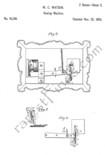


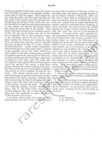
Condition:
The machine is complete, free of breaks or repairs. The paint is showing its age. Everything is moving and there is no problem with corrosion.There is even a needle!
History:
Grace Rogers Cooper wrote in her book, The Invention Of the Sewing Machine, on page 116:
Figure 126. - WATSON SEWING MACHINE, 1856, illustrated in Scientific American, December 13, 1856. The earliest Watson machines were two-thread lockstitch machines, as described in the Scientific American, August 10, 1850. Although the magazine reported that the inventor had applied for a patent, the earliest lockstich patent issued to Williams C. Watson was on March 11, 1856. A few of his machines were made in 1850, the article continued, "several of these machines are nearly finished ... person desirous of seeing them can be gratified by calling upon Messrs. Jones & Lee." A Watson machine was exhibited by Jones & Lee at the Sixth Exhibition of the Massachusetts Charitable Mechanics Association held in Boston in September 1850.The reason for the scarcity of any Watson Sewing Machines lies in the fact that Watson's sewing machines infringed in at least one patent, A.B. Wilson's patent, issued 22nd January 1856, owned at the time by O.B. Potter and N. Wheeler; and that the same sued Joel Chase who worked for Watson manufacturing the Watson $10 sewing machines. The following was published in newspapers at the time:
In 1853 a Watson machine was exhibited at the New York Industry of All Nations Exhibition, but this was a single-looping machine; Watson received a patent for his single-thread machine on November 25, 1856.
In the December 13, 1856, issue of Scientific American a machine called Watson's "Family" sewing machine was illustrated and described. It was a small machine (only 8 by 5 inches) manufactured by Watson & Wooster and selling for $10. References to the Watson single-thread machine occur as late as 1860, but no examples are known to have survived. (Smithsonian photo 48221-B.)
Watson's Ten Dollar Sewing MachineJoel Chase thereafter applied for a Patent on his own for a different feeding mechanism which was granted on December 1, 1857, patent # 18,732.
A Warning to the Public!
This machine, as stated below is a counterfeit, and all persons are hereby cautioned against selling, buying, or using them. Whenever and wherever they are found the law will be strictly enforced. All parties usning these machines, as well as those who vend them, make themselves liable for damages.
About the 20th day of August, 1856, I was employed by Messr. Watson, Wooster & Co., composed of Mm. C. Watson, Morris Keight, and Geo. H. Wooster, to manufacture Sewing Machines, which were known as the "Watson Ten Dollar Sewing Machine." That thereafter I received a notice from the counsel of O. B. Potter and N. Wheller; mentioned in the annexed copy of injunction, informing me that these Machines were an infringement upon Letters Patents which they owned, and that suit would be instituted against me, unless I should otherwise settle with them. This notice I handed to Mr. Wooster, one of my employers.
I then made investigations to ascertain the facts, and found that said Machine, as I believed, was an infringement of said Patent, and I informed said Watson that such was my opinion.
Subsequently a suit was commenced against me by said Potter and Wheeler, and immediately thereafter I so informed Mr. Watson, and I then told him that I would have nothing more to do with it, and I then ceased to make the Machines; and the injunction, a copy of which is hereto annexed, was issued and served upon me.
JOEL CHASE, Dated New York, Feb. 11th, 1857, In presence of Miles B. Andrus,
I do hereby certify that the above statement, subscribed by me, is correct and true.
JOEL CHASE
Inventory Number 09318;
Price: $ 6,250.00.
